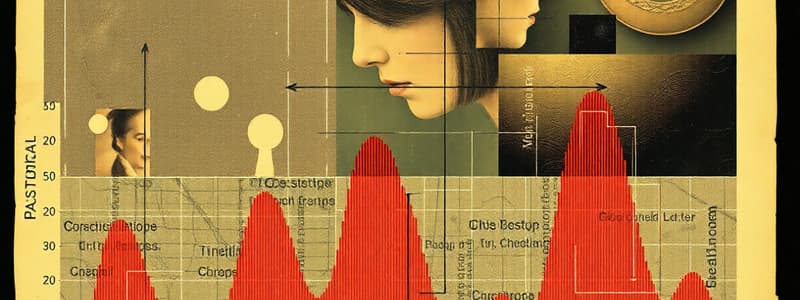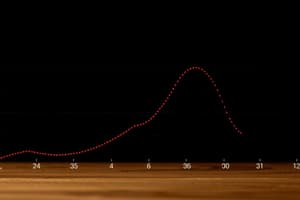Podcast
Questions and Answers
What does the Autocorrelation Function (ACF) measure?
What does the Autocorrelation Function (ACF) measure?
The first value in an ACF plot, p0, is always 0.
The first value in an ACF plot, p0, is always 0.
False (B)
What is the primary characteristic of the ACF for a stationary process?
What is the primary characteristic of the ACF for a stationary process?
The ACF decays quickly to zero as the lag increases.
A stochastic process is considered weakly stationary if its mean, variance, and autocovariance do not change over ______.
A stochastic process is considered weakly stationary if its mean, variance, and autocovariance do not change over ______.
Signup and view all the answers
Match the following time series processes with their ACF behavior:
Match the following time series processes with their ACF behavior:
Signup and view all the answers
What is the defining characteristic of a random walk?
What is the defining characteristic of a random walk?
Signup and view all the answers
An MA(q) process is not stationary.
An MA(q) process is not stationary.
Signup and view all the answers
Write the general equation for an AR(p) process
Write the general equation for an AR(p) process
Signup and view all the answers
For an AR(1) process to be stationary, the absolute value of the coefficient φ1 must be less than ______.
For an AR(1) process to be stationary, the absolute value of the coefficient φ1 must be less than ______.
Signup and view all the answers
What happens to the ACF of an MA(q) process after lag q?
What happens to the ACF of an MA(q) process after lag q?
Signup and view all the answers
Which function in R is commonly used to fit ARMA models?
Which function in R is commonly used to fit ARMA models?
Signup and view all the answers
The ACF of a random walk process typically declines rapidly.
The ACF of a random walk process typically declines rapidly.
Signup and view all the answers
What does 'p' represent in an AR(p) model?
What does 'p' represent in an AR(p) model?
Signup and view all the answers
A time series model assumes _ _ is a key assumption.
A time series model assumes _ _ is a key assumption.
Signup and view all the answers
Match the following terms with their definitions:
Match the following terms with their definitions:
Signup and view all the answers
What is a key property of the transition matrix P?
What is a key property of the transition matrix P?
Signup and view all the answers
The n-step transition probabilities can be obtained by subtracting the transition matrix from the identity matrix.
The n-step transition probabilities can be obtained by subtracting the transition matrix from the identity matrix.
Signup and view all the answers
What does the equation π = πP represent in the context of Markov Chains?
What does the equation π = πP represent in the context of Markov Chains?
Signup and view all the answers
A Markov chain is _ _ if it is possible to reach any state from any other state in a finite number of steps.
A Markov chain is _ _ if it is possible to reach any state from any other state in a finite number of steps.
Signup and view all the answers
What does it mean for a Markov Chain to be ergodic?
What does it mean for a Markov Chain to be ergodic?
Signup and view all the answers
Flashcards
Autocorrelation Function (ACF)
Autocorrelation Function (ACF)
A measure of the correlation between a time series and its past values at different lags.
ACF Plot
ACF Plot
A plot that visually represents the autocorrelation coefficients of a time series for different lags.
Weakly Stationary Process
Weakly Stationary Process
A stochastic process whose statistical properties like mean, variance, and autocovariance remain constant over time.
Random Walk
Random Walk
Signup and view all the flashcards
AR(p) Process
AR(p) Process
Signup and view all the flashcards
Stationarity Condition for AR(p)
Stationarity Condition for AR(p)
Signup and view all the flashcards
ACF Behavior in AR(p)
ACF Behavior in AR(p)
Signup and view all the flashcards
MA(q) Process
MA(q) Process
Signup and view all the flashcards
Stationarity Condition for MA(q)
Stationarity Condition for MA(q)
Signup and view all the flashcards
ACF Behavior in MA(q)
ACF Behavior in MA(q)
Signup and view all the flashcards
Weak Stationarity
Weak Stationarity
Signup and view all the flashcards
AR(p) Model
AR(p) Model
Signup and view all the flashcards
MA(q) Model
MA(q) Model
Signup and view all the flashcards
Transition Matrix
Transition Matrix
Signup and view all the flashcards
Stationary Distribution
Stationary Distribution
Signup and view all the flashcards
Ergodic Markov Chain
Ergodic Markov Chain
Signup and view all the flashcards
ACF (Autocorrelation Function)
ACF (Autocorrelation Function)
Signup and view all the flashcards
Model Diagnostics
Model Diagnostics
Signup and view all the flashcards
ARMA Model Fitting
ARMA Model Fitting
Signup and view all the flashcards
Study Notes
Autocorrelation Function (ACF) and Plot
- ACF measures correlation between time series and lagged values.
- Formula: pk = Cor(Yt, Yt-k)
- ACF plot visualises autocorrelation coefficients for different lags (k).
- First value (p0) is always 1 (correlation with itself).
- High pk (close to 1 or -1) indicates strong positive/negative correlation at lag k.
- Stationary processes show ACF decaying quickly to zero as lag increases.
- Non-stationary processes (e.g., random walk) show ACF declining slowly.
Weakly Stationary Process
- A stochastic process (Yt) is weakly stationary if:
- Mean (μ(t)) is constant over time.
- Variance (σ²(t)) is constant over time.
- Autocovariance (γ(t, s)) depends only on the lag (t-s), not specific time points (t and s).
- Implications: Statistical properties (mean, variance, autocovariance) remain unchanged over time.
- Many time series models (e.g., ARMA) assume weak stationarity.
Random Walk
- A stochastic process where current value is previous value plus random noise.
AR(p) Process (Autoregressive)
- AR(p) model: Current value (Yt) depends linearly on past p values and random noise.
- Formula: Yt = φ₁Yt₋₁ + φ₂Yt₋₂ + ... + φpYt₋p + εt
- εt is white noise.
- Stationarity condition: Roots of characteristic equation must lie outside the unit circle. Simplified for AR(1): |φ₁| < 1.
- ACF decays geometrically, rate depends on coefficients (φ₁...φp).
MA(q) Process (Moving Average)
- MA(q) model: Current value (Yt) depends linearly on past q random noise terms.
- Formula: Yt = εt + θ₁εt₋₁ + θ₂εt₋₂ + ... + θqεt₋q
- εt is white noise.
- Always stationary because finite linear combination of white noise.
- ACF cuts off after lag q (pk = 0 for k > q).
Interpretation of Time Series Output in R
- Model fitting: R functions (e.g., arma(), auto.arima()) estimate ARMA model parameters.
- Diagnostics: Check residuals for patterns and autocorrelations to verify white noise characteristics. This involves examining residual plots and ACF of residuals.
- Forecasting: Use fitted model to predict future values using R's forecast() function.
Studying That Suits You
Use AI to generate personalized quizzes and flashcards to suit your learning preferences.
Related Documents
Description
This quiz explores the concepts of Autocorrelation Function (ACF), weakly stationary processes, and random walks. Understand how ACF measures correlations in time series and the implications of weak stationarity in statistical models. Test your knowledge on these fundamental concepts in time series analysis.




